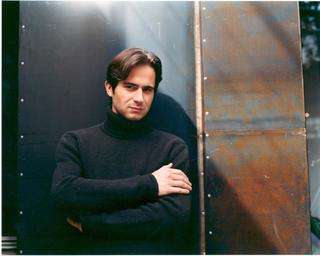|
Back
The Sounds of Central Europe New York
Zankel Hall, Carnegie Hall
05/01/2010 -
Karol Szymanowski: String Quartet No. 1, Op. 37 – Mythes, Op. 30 – Slopiewnie, Op. 46b
Leos Janácek: In the Mists
Béla Bartók: String Quartet No. 1 in A minor Op. 7
Iwona Sobotka (Soprano), Henning Kraggerud (Violin), Piotr Anderszewski (Piano), Belcea Quartet: Corina Belcea-Fisher, Laura Samuel (Violins), Krzysztof Chorzelski (Viola), Antoine Lederlin (Cello)

P. Anderszewski (© Sheila Rock/Virgin Classics)
Nobody’s drinking Champagne this weekend in New York. The only appropriate drinks are Polish or Russian vodka. Czech Slivovitz, or one of the newer Hungarian Tokays. (Tokays bottled under Communism are better dead than Red.)
In Lincoln Center, Valery Gergiev is resurrecting Stravinsky the way he should be played. Friday evening, Penderecki conducted four of his own compositions, so no questions about personal “interpretations”.
Last night and tonight (Sunday night) Eastern European musics from the Czech Republic, Hungary and Poland have been getting a severe workout under the direction of Polish pianist Piotr Anderszewski. While a solo recital would have been welcomed, he has been challenging the full-house enthusiastic audiences at Zankel Hall with an international selection of musicians and 20th Century music from Slavic (and near-Slavic) countries.
One cannot criticize Mr. Anderszewski for programming three works of the once-neglected Karol Szymanowski. Outside of the First Violin Concerto, he has been rarely played in New York. And we are more the losers.
Certainly this is true in the vocal music. Szymanowski loved the Middle and Near East, and many of his songs not only reflect Arabic modes, but they tell Arabic tales–rather prurient tales at that!!–in his music.
Last night, though, Polish soprano Iwona Sobotka made easy work of five lesser-known pieces translated loosely as Word Songs. Apparently these verses, based on Saint Francis, a lady martyr and the colors of the season are untranslatable. But the music held no terrors for Ms. Sobotka or Mr. Anderszewski. Like the semi-words, these were semi-melodies. Not following the words, one knew that she was passionate about what she was stating or singing. Had she been doing another composer, she might have appeared off-key, but with Szymanowski, these phrases used any number of grace notes, microtonal notes, or seemingly improvised phrases.
After, reading the poems, one realized that she was simply filling the hall with ravishing, yet amorphous music, music which we could take into our own minds and think what we wished.
The other unfamiliar Szymanowski was the First Quartet, played with equal passion by the Belcea Quartet. The first bars, with an ecstatic melody by the first violin, set the pace for the entire 20-minute work, including a lovely lush second movement and a jolly, if out-of-place finale. The problem with such a piece was its absolute intensity, giving this fine quartet little room for tonal changes. One could be fascinated by its playing, and then–aside from the opening–forget that it had happened.
That was equally true with the Bartók First Quartet, which never relaxes. With the Belcea Quartet, the dirge-like opening movement is so woebegone, and was played with such a lachrymose feeling that one had to wait patiently for the daylight to strike the finale.
This it did, and the quartet gave it a welcome sonority.
The Norwegian violinist Henning Kraggerud has such a bright tone coming from his 1744 Guarneri del Gesu that the three Szymanowski Mythes steamed ahead. “The Arethusa Fountain” gave a chance for both violinist and pianist to soar. But the final “Dryads and Pan” had the kind of unusual sound we usually find only in Bartók. Here were harmonics (apparently evoking Pan’s flute), quartet-tone tremolos (the forest?), and some good dancing for both instruments by the end.
It is hardly necessary to speak of Mr. Anderszewski’s In the Mists. He performed the Janacek here a few years ago, but he has changed it a bit. Originally it seemed improvised, an inner poem which could either communicate or not. We found ourselves in his pianist mists, and took the trip without questioning the destination.
That original mood has become more formal, but no less entrancing. Mr. Anderszewski now emphasizes the so intricate counterpoint. It no longer meanders but skirts on Beethoven, then back to impressionism, back to the enigmas of Janácek itself.
Then again, whatever Mr. Anderszewski performs is sensitive, intelligent and crafted with elegance. We are fortunate to have had his Szymanowski Symphony ten days ago, and two nights of him this week.
Nozdrovnié!!
Harry Rolnick
|